Bead head nymphs
{{start}}
I am a firm believer that when fishing rivers you have to get down to where the fish are holding and also that flies particularly in faster running water should include “hot spots”. These flies satisfy both these requirements for me and consequently have a place in my Bead head fly box.
{{end}}
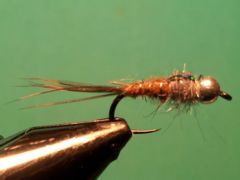
{{+1}}Marko’s go to fly{{-1}}
{{start}}
I was introduced to this fly at the 2012 World Fly Fishing Championships during the training sessions by our guide Marko Gradnik. This was his "go to" fly for all the river sectors of the competition and produced fish for all the Australian World team members.{{end}}

{{+1}}Riley nymph{{-1}}
{{start}}
This Joe Riley fly is a very generic representation of a mayfly nymph tied on a Czech nymph type hook. A good buggy looking fly that also has a hot spot emerging wing of UV material.{{end}}
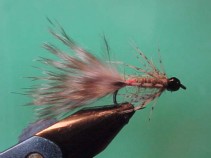
{{+1}}TBH hot butt caddis bugger{{-1}}
{{start}}
If your fishing in water with reasonably numbers of caddis your going to want to give this 3 cm bugger a swim. Caddis represent up to 70% of a trout's diet and whilst this fly is bigger than any caddis nymph I have seen trout love it. It is also a must tie on fly for discoloured water. You can fish it as a nymph but my preference is to fish it across, down and on the swing.{{end}}
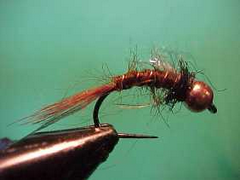
{{+1}}TBH chocolate caddis nymph{{-1}}
{{start}}
Caddis are are common throughout the year but with the greater concentrations occurring from September through to March. They inhabit both running and still water and are a significant food source for most trout often reputed to represent up to 30% of a trout's diet.{{end}}
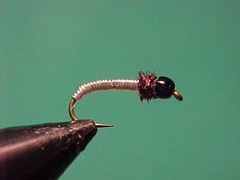
{{+1}}BH Brassie{{-1}}
{{start}}
The bead head version of the Brassie fly has been around for a long time and certainly has a place in ever river fly box. It's a handy fly to have on hand if you need a buggy looking fly that sinks like a brick or an anchor fly for a team of two or three flies. If this fly is a little heavy try the non bead head version QUICK LINK{{end}}
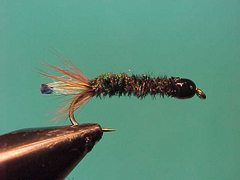
{{+1}}Bead head stick caddis{{-1}}
{{start}}
This is the lava of a Caddis fly (or Sedge) and is common from September through to December particularly in the flooded margins of lakes. The bead head version has been designed to be fished as an anchor fly when loch style fly fishing or as an anchor fly when fishing rivers.{{end}}
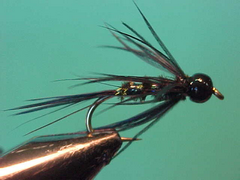
{{+1}}TBH dark magic – Chatto’s original{{-1}}
{{start}}
Hybrid spider nymphs are good buggy looking flies and the tail and soft hackle provide plenty of movement. One of these hybrid spider nymphs on the top dropper and two unweighted spiders or nymphs below can be a real tease for trout.{{end}}
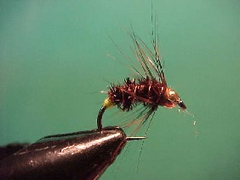
{{+1}}Hot butt spider – Chatto’s tie{{-1}}
{{start}}
Bead Head spider type flies are amongst the best flies for fishing fast rivers and streams. They are suggestive little flies and the combination of buggy shape, the peacock herl body, the movement of the soft hackle and the trigger of the hot butt often produce a hit. This mid water fly is suggestive of a drowned beetle. I tie the hot but in both fluoro fire orange and chartreuse as I find they are the best two trigger colours for trout. The orange works best either end of the river season and chartreuse comes into its own during the middle of the season when cased caddis are more prevalent.{{end}}
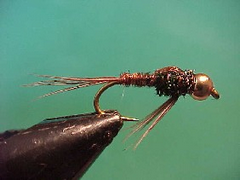
{{+1}}TBH pheasant tail nymph variant{{-1}}
{{start}}
The Pheasant Tail Nymph is a New Zealand pattern designed to suggest a small "Deleatidium Vernal" Mayfly. Whilst that family doesn't extend to Australia I suggest you still carry Pheasant Tail Nymphs or one or two of its variants in a couple of sizes because they are very buggy and particularly useful in faster water.{{end}}
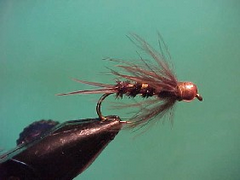
{{+1}}TBH CDC prince nymph{{-1}}
{{start}}
The bead head prince Cul-de-canard (CDC) nymph is a good buggy looking fly that is a variant of the original tie and has a form and function that in an "impressionistic" way incorporates the above shared characteristics. On top of that the CDC wing adds a lot of movement to the fly.{{end}}













